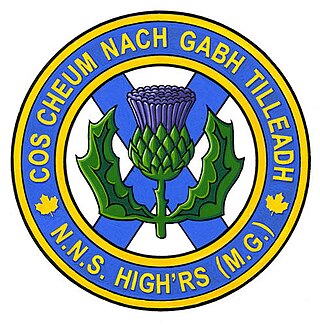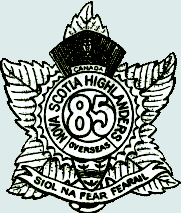Related Research Articles

The No. 2 Construction Battalion, Canadian Expeditionary Force (CEF), was raised in Nova Scotia and was one of two predominantly Black battalions in Canadian military history and the only Canadian battalion composed of Black soldiers to serve in World War I. Commanded by Lieutenant Colonel Daniel Hugh Sutherland, formerly of the 193rd Battalion, CEF.

The Nova Scotia Highlanders is an infantry regiment in the primary reserve of the Canadian Army. It is part of 36 Canadian Brigade Group, 5th Canadian Division.

The Prince Edward Island Regiment is a Primary Reserve armoured reconnaissance regiment of the Canadian Forces, 5th Canadian Division, 36 Canadian Brigade Group. The regiment is based in Charlottetown and Summerside, Prince Edward Island.

The North Nova Scotia Highlanders was an infantry regiment of the Canadian Army founded in 1936. In 1954, it was amalgamated with The Pictou Highlanders and 189 LAA RCA Battery to form 1st Battalion, The Nova Scotia Highlanders (North).
The Pictou Highlanders was an infantry regiment of the Canadian Army from 1871 until it was amalgamated into the Nova Scotia Highlanders in 1954.
The 173rd (Highlanders) Battalion, CEF, was a unit in the Canadian Expeditionary Force during the First World War. One of a number of Highlander battalions in the Canadian Expeditionary Force, it was based in Hamilton, Ontario, and began recruiting during the winter of 1915/16.
The 179th Battalion, CEF was a unit in the Canadian Expeditionary Force during the First World War. Based in Winnipeg, Manitoba, the unit began recruiting during the winter of 1915/16 in that city. After sailing to England in October 1916, the battalion was absorbed into the 17th Reserve Battalion on October 21, 1916. The battalion was disbanded on 17 July 1917. The 179th Battalion, CEF had one Officer Commanding: Lieut-Col. J. Y. Reid.
The 185th Battalion, CEF was a unit in the Canadian Expeditionary Force during the First World War.
The 134th Battalion, CEF was a unit in the Canadian Expeditionary Force during the Great War. Based in Toronto, Ontario, the unit began recruiting in late 1915 in that city. After sailing to England in August 1916, the battalion was absorbed into the 12th Reserve Battalion on March 7, 1918. The 134th Battalion, CEF had one Officer Commanding: Lieut-Col. A. A. Miller.
The 219th (Highland) Battalion, CEF was a unit in the Canadian Expeditionary Force during the First World War.
The 231st Battalion, CEF was a unit in the Canadian Expeditionary Force during the First World War. Based in Vancouver, British Columbia, the unit began recruiting in early 1916 in that city and the surrounding district. After sailing to England in April 1917, the battalion was absorbed into the 24th Reserve Battalion on April 22, 1917. The 231st Battalion, CEF had one officer commanding: Lieutenant-Colonel Francis Easton Leach. The battalion is perpetuated by the Seaforth Highlanders of Canada.
The 106th Battalion, CEF was a unit in the Canadian Expeditionary Force during the First World War. Based in Truro, Nova Scotia, with two additional companies in Pictou and Springhill, the unit began recruiting on 18 November 1915. The battalion was the first rifle regiment in Maritime Canada. The battalion sailed to England on 16 July 1916 and trained at Lower Dibgate, Shorncliffe. It was later broken up and most members were absorbed into the 40th Battalion, CEF.

The 85th Battalion, CEF, was an infantry battalion of the Canadian Expeditionary Force during the Great War. The 85th Battalion was authorized on 14 September 1915 and embarked for Great Britain on 12 October 1916. Disembarking in France in February 1917, it fought as part of the 12th Infantry Brigade, 4th Canadian Division in France and Flanders until the end of the war. The battalion is most famous for capturing Hill 145 in their first battle. Today, the Vimy Memorial stands on Hill 145.

The 25th Battalion, CEF was a unit in the Canadian Expeditionary Force during the Great War. It was the second infantry battalion of ten to be raised in Nova Scotia during the war. The 25th served in Belgium and France as part of the 5th Canadian Brigade, 2nd Canadian Division from 16 September 1915 until the end of the war. Regimental headquarters were established at the Halifax Armouries, with recruitment offices in Sydney, Amherst, New Glasgow, Truro and Yarmouth. Of the 1000 Nova Scotians that started with the battalion, after the first year of fighting, 100 were left in the battalion, while 900 men were killed, taken prisoner, missing or injured.
The 17th Battalion, CEF was a battalion of the Canadian Expeditionary Force during the Great War.
The 40th Battalion, CEF, was an infantry battalion of the Canadian Expeditionary Force during the Great War.

The 112th Battalion, CEF, was an infantry battalion of the Great War Canadian Expeditionary Force. The 112th Battalion was authorized on 22 December 1915 and embarked for Great Britain on 23 July 1916, where it provided reinforcements for the Canadian Corps in the field until 7 January 1917, when its personnel were absorbed by the 26th Reserve Battalion, CEF. The battalion disbanded on 15 August 1918.

The 113th Battalion, CEF, was an infantry battalion of the Great War Canadian Expeditionary Force. The 113th Battalion was authorized on 22 December 1915 as part of a recruiting drive in which men from the same region could enlist and serve together.
The Otter Commission, or Otter Committee, was established after the First World War to tackle a problem created by the chaotic mobilization of the Canadian Expeditionary Force. In 1919 units of the CEF, intended as a wartime expeditionary force, returned to Canada where the Canadian Militia had served during the war performing home defence duties, staffing internment camps, and raising recruits for overseas. Both the CEF and the Militia desired to be perpetuated in the post-war world. The CEF units were proud of their wartime record, while the pre-war Militia had long-standing roots in the community and battle honours dating back as far as the War of 1812.
The Cumberland Highlanders was an infantry regiment of the Non-Permanent Active Militia of the Canadian Militia. In 1936, the regiment was amalgamated with The Colchester and Hants Regiment to form The North Nova Scotia Highlanders.
References
- Meek, John F. Over the Top! The Canadian Infantry in the First World War. Orangeville, Ont.: The Author, 1971.
- ↑ "17th Reserve Battalion". Canadian Expeditionary Force Study Group. Retrieved 19 September 2020.